We first laid hands on AMD's Fusion series last February when we reviewed the 18W dual-core Zacate APU, formally known as the E-350. Designed for netbook-like applications, the Zacate APUs brushed aside existing Intel solutions with ease, providing an affordable yet powerful to the then common Atom/Ion combo.
Shortly after Zacate's release, we had an opportunity to test AMD's A8-3850 desktop APU, codenamed Llano, which featured "Husky" CPU cores that were essentially the mobile Phenom II architecture along with Redwood-class integrated graphics (WinterPark for the dual-core variants and BeaverCreek for the quad-core versions).
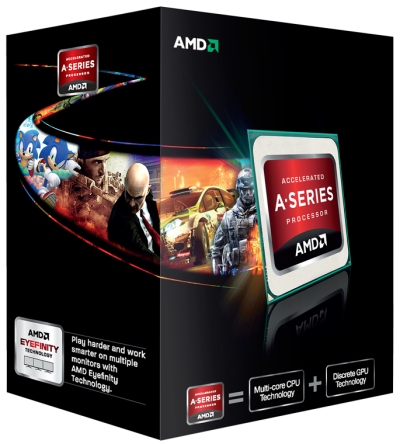
Like Zacate, we felt Llano was going to be a success for AMD, and for the most part, it has been a hit among certain users. Even today, top-end Intel chips such as the Core i7-3770K can't beat the A8-3850's graphics performance, while many Ivy Bridge-based Core i5 and i7 parts have an even slower HD 2500 graphics engine.
Granted, Intel still dominates the processor market and its products are generally the way to go if you want the fastest CPU possible. However, AMD's APUs provide an attractive alternative for folks who don't need the horsepower of Ivy Bridge or a discrete GPU, but still want more graphics power than Intel's IGPs.
AMD has continued refining its Fusion offerings, launching its Trinity series four months ago on mobile platforms – arguably where its APUs provide the most value. These 32nm parts feature four CPU cores based on Piledriver, Bulldozer's successor, and a GPU based on Cayman of 2010's Northern Islands (HD 6000) series.
This week, AMD is finally prepared to offer a desktop version of Trinity, which brings a new socket and a new high-end chipset. Given that Piledriver improved Bulldozer's power consumption, we expect Trinity to be more efficient than Llano, while Cayman's VLIW4 architecture should boost the GPU's speed – or so we hope.
32nm Trinity Line-up
Piledriver cores are spread across three different 32nm APU series: Trinity, Weatherford and Richland. We'll be looking exclusively at Trinity, which covers the performance segment and replaces the Llano-based A8-series. Weatherford covers the upper-mainstream market, replacing the Llano-based A6-series, while Richland covers the lower-mainstream territory, replacing the Llano based A4-series.
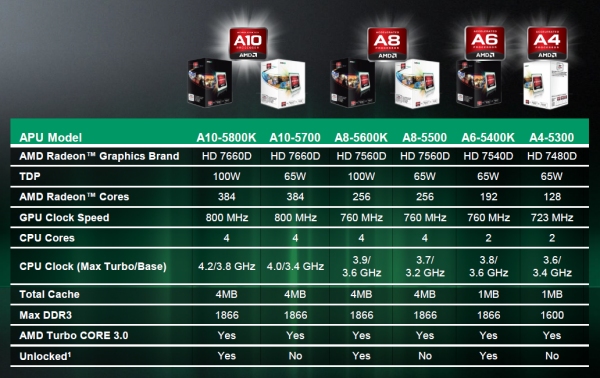
There are six new Piledriver-based APUs, four of which are of the Trinity line, and we'll be testing the A10-5800K, a quad-core part that operates at 3.8GHz with a maximum turbo frequency of 4.2GHz and boasts a 4MB L2 cache. Its GPU is known as the Radeon HD 7660D, which features 384 cores and operates at 800MHz. Like Intel's "K" series processors, the A10-5800K unlocked for easier overclocking.
A-Series Core Design
As mentioned, Trinity's Piledriver cores are based on the same Bulldozer architecture used by the current FX series. However, AMD has changed the design slightly. For example, the L3 cache has been abandoned. The new A10 and A8 APUs match the FX-4000 series with 4MB of L2 cache, while the A6 and A4 parts have just 1MB.
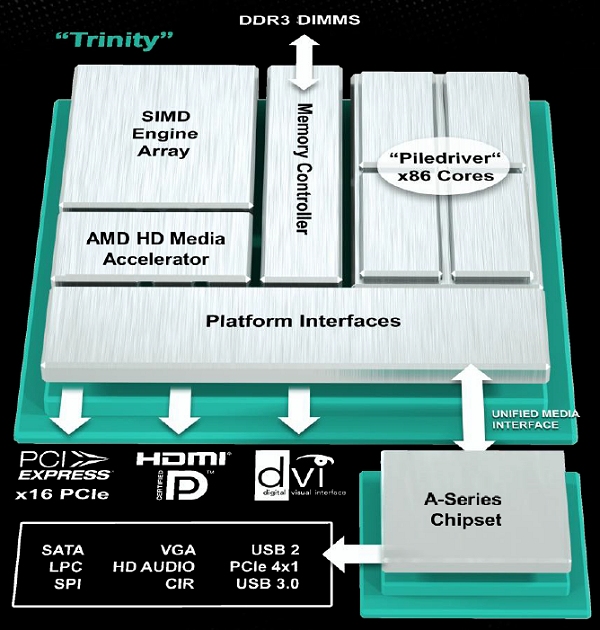
Although L3 cache increases performance in certain situations, it also elevates power consumption and essentially ruins the efficiency of these chips. Whereas the smaller dedicated L2 cache can be enabled or disabled as the cores are needed, the entire L3 cache stays awake even when only one core is being used. Apparently, AMD felt the performance tradeoff wasn't worth it.
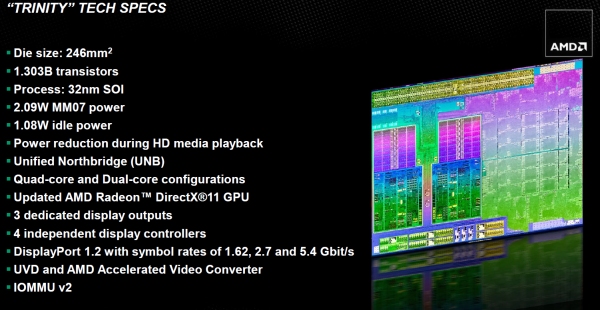
Despite dropping the L3 cache, Trinity's transistor count is still greater than the Phenom II X6 1100T and AMD FX-8170. In fact, Trinity's transistor count is only slightly lower than Intel's Core i7 Ivy Bridge (22nm) processors.
The die area of the quad-core APUs is 246mm², which is larger than the 160mm² die of high-end Ivy Bridge Core i5 and Core i7 processors. Naturally, larger dies cost more to produce, and considering the Trinity APUs are significantly larger than their competition, we have no doubt this will cut into AMD's bottom line.
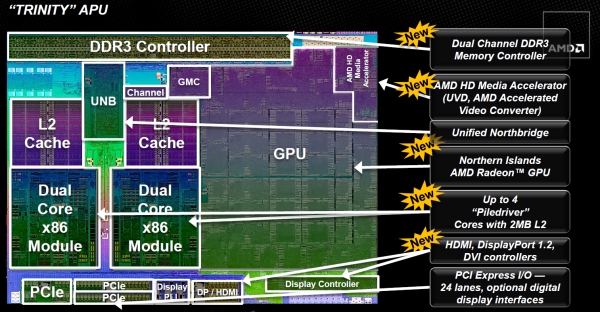
That said, Trinity and its ilk are incredible when you look at processors and platforms from just a few years ago. AMD has taken a 66mm² (13w) northbridge, 200mm² (65-95w) quad-core processor, 108mm² (30w) graphics processing unit – what were once three entirely separate components – and merged them into a 246mm² (65-100w) A-Series APU.
